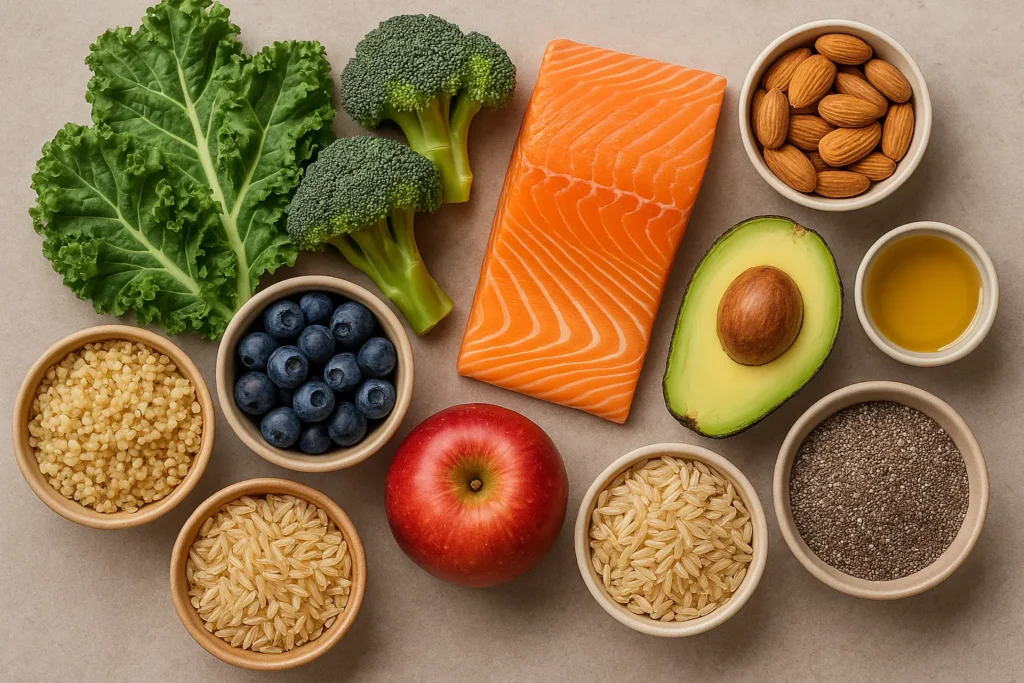Looking to finally break the cycle of diets that don’t work? Wondering if Ozempic can help you shed stubborn belly fat in just six weeks? This article explores everything you need to know about the 6 week plan Ozempic weight loss results, including how Ozempic works, what kind of progress to expect week by week, real before-and-after stories, clinical facts, and safe strategies to support your journey. Whether you’re just starting Ozempic or seeking to optimize results, this guide is your all-in-one resource.
Also Read: How Does Compounded Semaglutide Compare to Ozempic for Weight Loss
What Is Ozempic and How Does It Work?
Ozempic (semaglutide) is a GLP-1 receptor agonist originally approved for managing type 2 diabetes. It works by mimicking the effects of the hormone glucagon-like peptide-1, which helps regulate appetite, insulin levels, and blood sugar.
Key Weight Loss Mechanisms:
- Appetite Suppression: Feel full faster and longer.
- Slows Gastric Emptying: Delays how quickly food exits the stomach.
- Improves Insulin Sensitivity: Especially beneficial for people with insulin resistance or prediabetes.
- Supports Caloric Deficit: Makes eating less feel more natural.
Preparing for the 6-Week Ozempic Journey
Before diving in, it’s important to prepare mentally and physically. Ozempic is not a magic pill—it works best when paired with dietary changes and consistent exercise.
Pre-Journey Tips:
- Medical Consultation: Ensure Ozempic is right for you.
- Set Realistic Expectations: Aim for 2–4% body weight loss in 6 weeks.
- Start a Health Journal: Track food, dosage, energy, and mood.
- Know the Side Effects: Be aware of common issues like nausea or fatigue early on.
Week-by-Week: 6 Week Ozempic Weight Loss Plan
This section provides a detailed week-by-week breakdown of the 6 week Ozempic weight loss plan. Learn what to expect, dosage changes, and how your body may respond over time.
Week 0: Baseline and Planning
- Set your weight loss goals.
- Track weight, waistline, and health markers.
- Learn proper injection techniques.
- Clean up your pantry and meal prep for success.
Week 1–2: Initiation Phase
Dosage: 0.25 mg/week (starting dose)
Focus: Getting used to the medication.
- Expect appetite changes and possible nausea.
- Stick to bland, small meals.
- Begin light activity like walking or stretching.
Pro Tip: Avoid alcohol and fatty foods that may worsen side effects.
Week 3–4: Adjustment Phase
Dosage: Increase to 0.5 mg/week
Focus: Establishing routine and ramping up results.
- Appetite suppression intensifies—calorie intake drops.
- Add fiber-rich vegetables and lean proteins.
- Begin moderate workouts (cycling, yoga, strength bands).
Expected Results: Noticeable weight drop (1–3% of body weight), reduced cravings, improved energy.
Week 5–6: Optimization Phase
Dosage: As directed, often maintained at 0.5 or increased to 1 mg/week.
Focus: Maximize fat loss and build healthy habits.
- Track results and adjust meal plans as needed.
- Add strength training to preserve muscle mass.
- Reinforce healthy sleep, hydration, and stress management.
Results: Up to 4%+ weight loss, visible belly fat reduction, improved metabolic health.
Diet Tips During the 6-Week Plan
Pairing Ozempic with a clean, balanced diet is essential for maximizing weight loss and supporting overall health. Since Ozempic works by regulating appetite and slowing digestion, consuming the right foods can help manage hunger, avoid gastrointestinal discomfort, and support long-term fat reduction—especially around the belly. Here’s a more detailed look at the best diet practices to follow during your 6-week Ozempic plan:
Foods to Eat

Focus on nutrient-dense, whole foods that support satiety, metabolic function, and gut health. These will complement the effects of Ozempic and help reduce body fat more effectively:
- Leafy Greens & Cruciferous Vegetables
(e.g., spinach, kale, broccoli, cauliflower)
These are low in calories and high in fiber, vitamins, and antioxidants. They promote fullness and digestive regularity without adding excessive carbs. - Lean Proteins
(e.g., chicken breast, turkey, fish like salmon and cod, tofu, legumes)
Protein is essential for preserving muscle mass during weight loss. It also requires more energy to digest, which increases calorie burn and keeps you fuller longer. - Whole Grains
(e.g., quinoa, oats, brown rice, farro)
Complex carbohydrates are slowly digested, keeping blood sugar levels stable. Whole grains also add fiber to your meals, which supports weight loss and reduces cravings. - Low-Glycemic Fruits
(e.g., berries, apples, pears, peaches)
These fruits are rich in antioxidants, vitamins, and fiber, and they help satisfy sweet cravings without spiking insulin levels. - Healthy Fats
(e.g., avocados, olive oil, chia seeds, almonds, walnuts)
Healthy fats support hormone balance, brain function, and long-lasting satiety. Just be mindful of portion sizes, as fats are calorie-dense.
Foods to Avoid

Some foods can interfere with your progress on Ozempic, cause digestive distress, or stall fat loss—especially in the abdominal region. Avoid or strictly limit:
- Fried and Greasy Foods
(e.g., fried chicken, French fries, chips)
These can cause nausea or stomach upset while on Ozempic. They’re also calorie-dense and often low in nutrients, which works against weight loss. - High-Sugar Snacks and Beverages
(e.g., soda, energy drinks, pastries, candy)
These spike blood glucose levels, contribute to fat storage (especially visceral fat), and disrupt Ozempic’s appetite-regulating effects. - Ultra-Processed and Fast Foods
(e.g., burgers, frozen pizzas, packaged microwave meals)
These often contain hidden sugars, sodium, and unhealthy fats. They may slow down metabolism, increase bloating, and make it harder to maintain a calorie deficit.
Bonus Tips:
- Stay Hydrated: Aim for 8–10 glasses of water daily. Proper hydration helps digestion, prevents overeating, and supports metabolic function.
- Mindful Eating: Eat slowly and without distractions to recognize hunger and fullness cues more effectively—this enhances the satiety effects of Ozempic.
- Meal Timing: Try eating smaller, frequent meals to avoid overloading your digestive system, especially during the first few weeks of medication.
By sticking to these dietary guidelines throughout the 6-week Ozempic plan, you’ll optimize your results and build a foundation for sustained weight loss success.
Exercise Guide for Maximum Results
Incorporating physical activity into your Ozempic journey significantly enhances the medication’s fat-burning effects—especially around the midsection. While Ozempic helps regulate appetite and blood sugar, exercise adds the crucial element of increased energy expenditure, boosts mood, supports muscle retention, and improves metabolic health. Together, they create a powerful synergy for sustainable weight loss.
Here’s a detailed weekly fitness plan designed to complement Ozempic’s mechanism of action:
Weekly Plan Overview
3x per Week: Brisk Walking or Light Cardio (30–45 minutes per session)
Low-impact aerobic exercise—such as brisk walking, cycling, swimming, or elliptical training—helps burn calories, improve cardiovascular health, and mobilize stored fat. It’s especially effective for reducing visceral belly fat, which is often the target area during weight loss.
- Try walking after meals to aid digestion and control post-meal glucose spikes.
- Maintain a pace that slightly increases your breathing but still allows conversation.
2x per Week: Resistance Training (20–30 minutes per session)
Building lean muscle mass is key during any weight loss program to prevent muscle loss and boost resting metabolism. Strength training also improves insulin sensitivity, complementing Ozempic’s glucose-regulating benefits.
- Use bodyweight exercises like squats, lunges, and pushups.
- Try resistance bands or light dumbbells for added challenge without strain.
- Focus on compound movements to engage multiple muscle groups.
Daily: Stretching or Gentle Yoga (10–15 minutes per day)
Stretching increases flexibility, reduces soreness from workouts, and supports joint health. Gentle yoga enhances circulation and helps with balance and mental relaxation—both valuable during a lifestyle change.
- Incorporate poses like Child’s Pose, Cat-Cow, and Downward Dog.
- Use this time as mindfulness practice to ease anxiety or emotional eating triggers.
Why Exercise Helps with Ozempic Side Effects
Many Ozempic users report mild side effects during the first few weeks, such as:
- Nausea
- Low energy
- Digestive sluggishness
Exercise can counteract these effects by:
- Enhancing digestion and circulation
- Reducing stress and boosting endorphins (natural mood elevators)
- Improving sleep quality, which further supports metabolic repair and appetite regulation
Mental Clarity and Motivation
Regular physical activity isn’t just good for your body—it also sharpens your mind. Exercise boosts cognitive function, memory, and mental clarity. These benefits can help you stay focused, committed, and emotionally balanced during your 6-week plan.
Tips for Success
- Start slow: If you’re new to exercise, begin with short walks or light stretching, gradually increasing intensity.
- Listen to your body: On Ozempic, you may have reduced appetite and energy, so avoid overexerting yourself early on.
- Stay consistent: Consistency matters more than intensity—stick to your routine even if progress feels slow.
By combining Ozempic with this structured yet flexible fitness approach, you can accelerate weight loss, sculpt a stronger body, and build habits that extend far beyond the 6-week window.
Common Challenges and How to Overcome Them
During your 6-week Ozempic journey, you may face hurdles like nausea, fatigue, or weight loss plateaus. This section offers practical solutions to help you stay consistent and motivated.
Nausea
- Eat slowly and in smaller portions.
- Ginger tea or bland foods can help.
- Stay upright for 30 mins post-meal.
Weight Plateaus
- Switch up workout routines.
- Slightly lower carb or fat intake.
- Increase daily step count.
Real Ozempic 6 Week Weight Loss Before and After Results
Curious about real transformations? These Ozempic 6-week weight loss before and after results showcase noticeable changes in belly fat, energy levels, and confidence—backed by consistency and healthy habits.
Belly Fat Transformation:
Before: High cravings, bloating, belly fat storage.
After 6 Weeks: Leaner waistline, less bloating, better energy and self-image.
“Ozempic was the nudge I needed. By week 6, I lost nearly 12 lbs, and my jeans fit again.” – Anonymous user on Reddit
Clinical Data:
- In clinical trials, most participants lost 2–4% of their weight by week 6.
- Visceral fat (belly fat) is especially responsive to Ozempic + diet changes.
- Waist circumference drops typically align with early weight reductions.
Visual Progress: 6 Week Ozempic Weight Loss Before and After
The images below showcase real transformations from individuals who followed the 6-week Ozempic plan. These side-by-side photos highlight noticeable reductions in belly fat, improved body shape, and enhanced overall well-being. Each transformation reflects the power of consistency, proper diet, physical activity, and medically guided Ozempic use.


Medical Guidance and Safety Warnings
Before starting Ozempic, it’s essential to consult a healthcare professional to assess suitability based on your medical history. Safety monitoring, proper dosage, and awareness of side effects like nausea or thyroid risks are crucial for a safe and effective weight loss journey.
Who Should Avoid Ozempic?
- History of medullary thyroid cancer
- Pancreatitis
- Pregnant or breastfeeding
- Severe gastrointestinal issues
Monitor With a Doctor If You Have:
- Type 2 Diabetes
- Insulin resistance
- Cardiovascular risk factors
Always start with a supervised plan and get regular check-ups.
The Role of Insurance & Affordability
- Private Insurance: Often covers Ozempic for diabetes, not weight loss.
- Medicaid: Varies by state.
- Novo Nordisk Savings Card: May reduce out-of-pocket costs for eligible patients.
Maintaining Results After 6 Weeks
Maintaining your Ozempic weight loss results after 6 weeks requires long-term commitment to healthy habits. Continue following a balanced diet, regular exercise routine, and schedule follow-ups with your doctor to stay on track and prevent weight regain.
Lifestyle After the Plan
- Continue healthy eating and workout routines.
- Reduce stress—cortisol increases belly fat.
- Stay hydrated and prioritize quality sleep.
Long-Term Strategy
- Re-evaluate with your doctor: Should you continue Ozempic?
- Add variety to workouts and meals to prevent boredom.
- Consider DEXA scans to track muscle and fat composition.
Frequently Asked Questions
Final Thoughts
The 6 week plan Ozempic weight loss results are promising, but they aren’t automatic. The medication amplifies your efforts—what you eat, how you move, and your commitment to the process are what drive transformation. If you’re ready to reduce belly fat, improve your health, and take control of your weight, Ozempic can be a game-changing ally—but only when used responsibly and as part of a larger lifestyle strategy.
Ready to take the next step? Talk to your doctor about starting a 6-week Ozempic plan tailored to your needs. Sustainable weight loss is within reach—one week at a time.
Disclaimer: The content on Wellness Derive is for informational purposes only and not a substitute for professional medical advice, diagnosis, or treatment. Always consult a healthcare provider for medical concerns.



